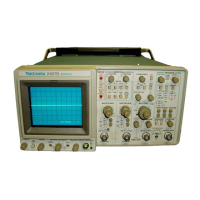Theory of Operation—2465B/2467B Service
Amplifier gain and vertical centering are adjusted by
R638 and R639 respectively, primarily to match the
amplifier hybrid to the crt installed in the instrument. On
the 2465B, the Dynamic Centering circuit sinks an
intensity-dependent correction current away from the
verti-
cal centering input at pin 39. The correction signal holds
the vertical centering stable over a wide range of varying
display intensities. Readout jitter adjustment pot R618 is
used to minimize thermal distortion in the output amplifier
to reduce jitter in the display readout.
The vertical output signal at pins 28 and 33 of U600
(OUT A and OUT B) is applied to the vertical deflection
plates of the crt (diagram 8) via L628 and L633. The
deflection plates form a distributed-deflection structure
that is terminated by a hybrid resistor network. One ele-
ment of the terminating network is an adjustment poten-
tiometer used to match the network impedance to that of
the crt.
BANDWIDTH LIMITING. Bandwidth limiting coils L644
and L619, along with capacitors built into U600, form a
three-pole filter used to roll off high-frequency response of
the Vertical Output amplifier above 20 MHz. To limit the
vertical bandwidth, the BWL (bandwidth limit) input to
U600 (pin 16) is pulled LO. It may be set LO either by the
BWL control data bit from Auxiliary Control Register U140
(diagram 4) when the operator selects the Bandwidth Limit
feature or automatically by the output of NAND-gate
U975A in the Vertical Channel Switch circuitry (via CR616)
when the readout is being displayed.
TRACE SEPARATION. The voltage applied to the TS
(trace separation) input of U600 (pin 42) is used to offset
the output levels to vertically shift the position of the trace
on the crt. During normal sweep displays, TS1 + TS2
signal applied to the base of Q600 by the Display
Sequencer (diagram 5) is HI, and the transistor is turned
on.
The TRACE SEP level at the junction of R642 and
CR600 is shunted to ground, and no offsetting at the
output signal will occur. For those displays in which trace
separation should occur, the Display Sequencer switches
the base of Q600 to ground level to turn off the transistor.
The trace separation level set by front-panel TRACE SEP
control R3190 (via MUX U2530 and sample-and-hold
circuit U2630C and C2631) is applied to the TS input of
U600,
and a corresponding offset of the displayed trace
will occur.
BEAM FIND. As an aid in locating off-screen or
overscanned displays, the instrument is provided with a
beam-finding feature. When the front-panel BEAM FIND
button is pushed, the beam-find input pin (BF, pin 15) of
U600 will be pulled HI. While BF is HI, the dynamic range
of Vertical Output Amplifier U600 is reduced, and all
deflected traces will be held to within the vertical limits of
the crt graticule.
Also,
the activation of the BEAM FIND switch is
detected by the microprocessor during its normal Front-
Panel Switch Scanning. When detected, the microproces-
sor initiates a CRT Wakeup sequence for 2467B instru-
ments and generates a User Request SRQ if option 10 is
installed.
OUTPUT PROTECTION CIRCUIT. A current-limit circuit
composed of transistors Q623 and Q624 protects the
Vertical Output Amplifier from a short-circuited output or a
bias-loss condition. Either of these fault conditions will
cause excessive current to flow into pins 30 and 31 of
U600.
Current in FET Q624 is limited to the IDSS current,
so the voltage at pins 24, 30 and 31 will drop. This
decreases the forward bias on pass-transistor Q623 and
lowers the voltage at pin 23 of U600 enough to provide
some degree of protection for the device.
Horizontal Amplifier
The Horizontal Amplifier circuitry consists of a Horizon-
tal Output Amplifier U800, a unity-gain buffer amplifier
made up of the five transistors in U735, and associated
components.
UNITY-GAIN BUFFER AMPLIFIER. The amplifier circuit
composed of U735A, B, C, D, and E along with their
associated components, form a unity-gain amplifier that
buffers the ramp signal from A Sweep Generator U700 to
the Horizontal Output Amplifier. Transistors U735C and D
form a differential pair with the negative excursion of their
emitters limited to -5 V (clamped by U735E). Negative
feedback from the collector of U735C to its base is via
emitter-followers U735A and B (in parallel) which drive the
A Sweep input (pin 18,
A
+
)
of Horizontal Output Amplifier
U800.
HORIZONTAL OUTPUT AMPLIFIER. Integrated circuit
U800 provides the final amplification of the selected
horizontal-deflection signal required to drive the crt. One of
the single-ended input signals applied to the four input pins
is converted to a differential-output signal at the output
pins of the amplifier. The four deflection signals to U800
are:
the A sweep (pin 18,
A
+
),
the B Sweep (pin 16,
B
+ ),
the Readout Horizontal signal (pin 17, RO) and the
Channel 1 signal (used for horizontal deflection of the X-Y
displays) at pin 20, the X+ input pin. Signal selection is
done by an internal channel switch and is controlled by the
HSA (horizontal select A) and HSB (horizontal select B)
signals from the Display Sequencer (see Table 3-4).
3a-25

